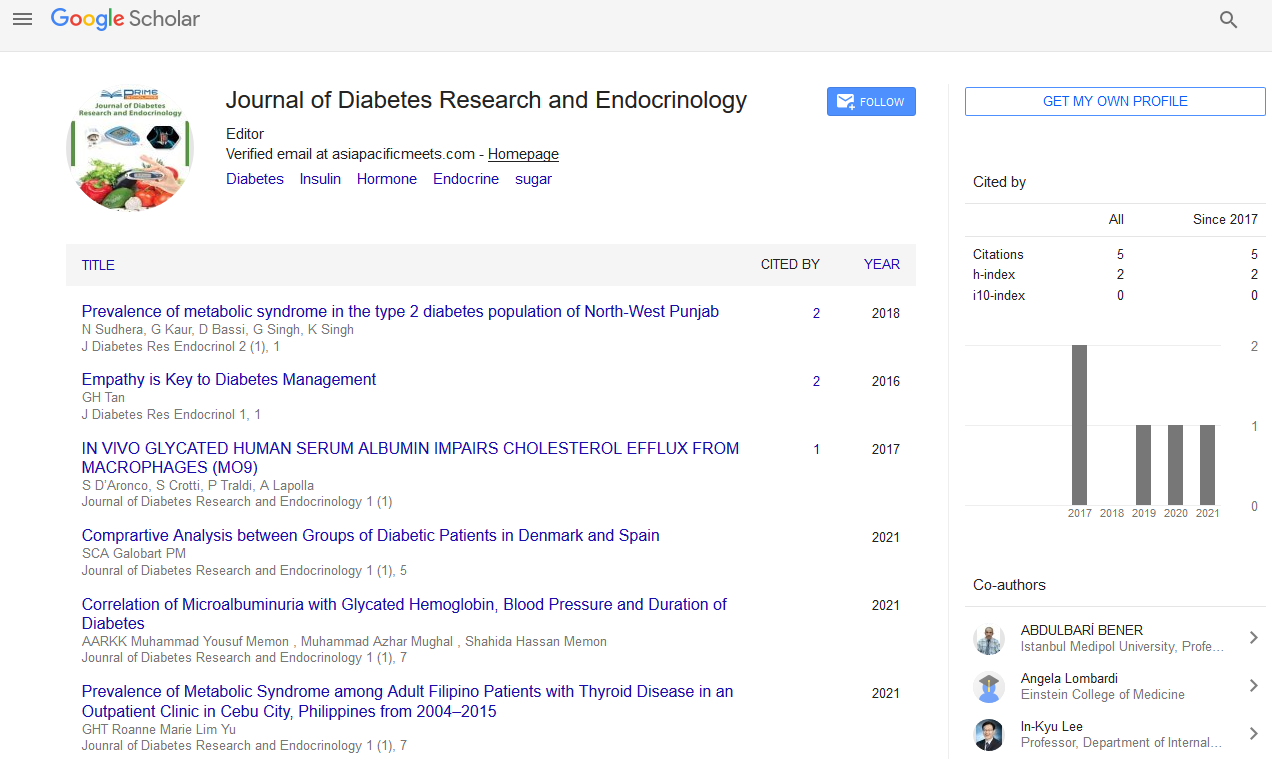Opinion - (2024) Volume 8, Issue 1
Impact of Lifestyle Interventions on Diabetes Prevention
Alexander Hall*
Department of Endocrinology, Chichester University, UK
*Correspondence:
Alexander Hall,
Department of Endocrinology, Chichester University,
UK,
Email:
Received: 28-Feb-2024, Manuscript No. IPJDRE-24-20064;
Editor assigned: 01-Mar-2024, Pre QC No. IPJDRE-24-20064 (PQ);
Reviewed: 15-Mar-0204, QC No. IPJDRE-24-20064;
Revised: 20-Mar-2024, Manuscript No. IPJDRE-24-20064 (R);
Published:
27-Mar-2024, DOI: 10.36648/ipjdre.08.01.08
Introduction
Diabetes mellitus, particularly type 2 diabetes (T2D), poses a
significant global health challenge. With its prevalence rapidly
increasing, there is a pressing need for effective prevention
strategies. Lifestyle interventions, focusing on diet, physical
activity, and weight management, have proven to be pivotal
in preventing the onset of T2D. This article delves into the
impact of these lifestyle interventions on diabetes prevention,
highlighting key research findings and practical approaches
for implementation. Lifestyle interventions are foundational
in addressing the modifiable risk factors for T2D. Unlike
pharmacological treatments, lifestyle changes can have broad
and holistic benefits, improving overall health and reducing the
risk of multiple chronic diseases. The primary components of
lifestyle interventions include dietary modifications, increased
physical activity, and sustained weight loss. Adopting a diet rich
in fruits, vegetables, whole grains, lean proteins, and healthy
fats is crucial. The Mediterranean diet, for instance, emphasizes
these components and has been associated with a lower risk of
developing T2D. Minimizing intake of processed foods, sugary
beverages, and high-fat foods helps reduce insulin resistance
and improves glucose metabolism. Choosing foods with a low
Glycaemic Index (GI) can help maintain stable blood sugar levels.
Description
Foods with a low GI are digested and absorbed more slowly,
causing a gradual rise in blood sugar levels. Engaging in regular
physical activity, such as brisk walking, running, cycling, or
swimming, improves insulin sensitivity and glucose uptake by
muscles. The American Diabetes Association recommends at
least 150 minutes of moderate to vigorous aerobic activity per
week. Incorporating strength training exercises at least two days
a week can further enhance insulin sensitivity and promote
muscle health. Excess body weight, particularly visceral fat, is
a major risk factor for T2D. Weight loss of even 5-10% of body
weight can significantly reduce the risk of developing diabetes.
Combining dietary changes with physical activity is essential for
achieving and maintaining weight loss. Behavioural strategies,
such as goal setting, self-monitoring, and seeking social
support, are critical for long-term success. Several landmark
studies have demonstrated the efficacy of lifestyle interventions
in preventing T2D The DPP was a major multicentre clinical
research study that compared the effectiveness of lifestyle
intervention, metformin therapy, and placebo in preventing
T2D in individuals with prediabetes. The lifestyle intervention
group, which focused on diet, physical activity, and weight loss,
achieved a 58% reduction in the incidence of T2D compared
to the placebo group. This effect was even more pronounced
among participants aged 60 and older, with a 71% reduction. The
DPS demonstrated that lifestyle interventions, including dietary
changes and increased physical activity, reduced the incidence
of T2D by 58% over a four-year period among individuals with
impaired glucose tolerance.
Conclusion
Tailoring lifestyle interventions to individual preferences,
cultural practices, and health status enhances adherence
and effectiveness. Providing behavioural support through
counselling, coaching, and peer support groups helps individuals
overcome barriers and sustain lifestyle changes. Communitybased
programs and policy initiatives that promote healthy
eating and physical activity environments are crucial for largescale
diabetes prevention efforts. Utilizing digital health tools,
such as mobile apps, wearable devices, and online platforms,
can support individuals in tracking their progress and staying
motivated. Lifestyle interventions play a critical role in preventing
type 2 diabetes by addressing modifiable risk factors through
dietary changes, physical activity, and weight management. The
evidence from major studies underscores the effectiveness of
these interventions in reducing diabetes risk. By implementing
individualized, community-supported, and technology-enabled
approaches, we can enhance the adoption and sustainability
of healthy lifestyle behaviours, ultimately curbing the growing
diabetes epidemic.
Citation: Hall A (2024) Impact of Lifestyle Interventions on Diabetes Prevention. J Diab Res Endocrinol. 8:08.
Copyright: © 2024 Hall A. This is an open-access article distributed under the terms of the Creative Commons Attribution License, which permits unrestricted use, distribution, and reproduction in any medium, provided the original author and source are credited.

